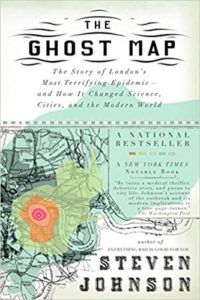The Ghost Map by Steven Johnson

The Ghost Map : The Story of London’s Most Terrifying Epidemic–and How It Changed Science, Cities, and the Modern World
by Steven Johnson
Compare a bacteria with a human, with a city, with the planet. Weave in two personal stories and the clash of ideas and of the inherent messiness of progress, and you may get the outline of this book. The Ghost Map is at once a real map, but also a metaphor for progress, for navigation of the future using the past.
The scale at which this book is written jumps all the time and could have collapsed in on itself because it constantly pans and zooms through its subject matter, yet it always stays focused and gripping. The book’s main story are the events around an outbreak of Cholera in London in 1854 around Broad Street, Soho. Two very different people, John Snow and Henry Whitehead, became entangled in the outbreak and eventually through their efforts the battle against Cholera was won, mega cities became possible and the foundations for modern epidemiology were laid.
But to sum it up thus would be to rob this book of its layered approach and the way it branches out to touch on lots of other subjects. At the end of the day this is also a very positive book. The battle against Cholera in London that Johnson describes is a winning battle, and he further speculates other Bacteria may have about a fifty year window of opportunity to cause a real massive global outbreak, but that window of opportunity is already closing.
It’s a book that in the end celebrates the city and the now fast urbanising planet where we live, we passed the 50% human population living in cities a few years ago already (2009). In 1854 when only 10% of the worlds population was living in cities (up from 2% at the start of that century) the city was an unsustainable monster.
London at the time the worlds biggest, greatest city ever seen on the planet also seemed to be about to collapse in on itself under the stench of human existence, the sheer scale of death through bad sanitation and healthcare nowadays for example would be absolubtely unacceptable.
Nobody was more sure of Londons collapse at the time then Londoners themselves. Yet the fighting of Cholera, in both the cities response and the new scientific methodology applied to it’s fighting paved the way for the biggest fundamental change in the way we live toady. It allowed humans to become a race of urban animals. This is in the end a celebration of cities and belief in their abilities to deliver a better life for people all over the world. They are as Steven Johnson points out the place where discoveries are made, and art is created. They are the places with better access to jobs, healthcare and education, the places where your environmental impact is minimised.
For me as an Architect the book also praises the way of contingent thinking I wish Architects and planners did more often. Being able to think across many scales at the same time and crossing disciplines, of asking why something is done like it is and not another way. Sometimes the lessons of thinking freshly and deeply at problems from a different perspective are lost too easily in looking merely at simplistic urban mechanisms or aesthetic considerations when making design and planning judgements.
It’s a sobering thought that although its many years since Cholera should have been finally fully conquered, it just won’t go away in the developing world with the recent outbreaks in Zimbabwe being just one of the many examples. However you will come away from reading this book feeling more positive about the many problems we face at this time in human history. A worthy and insightful read.